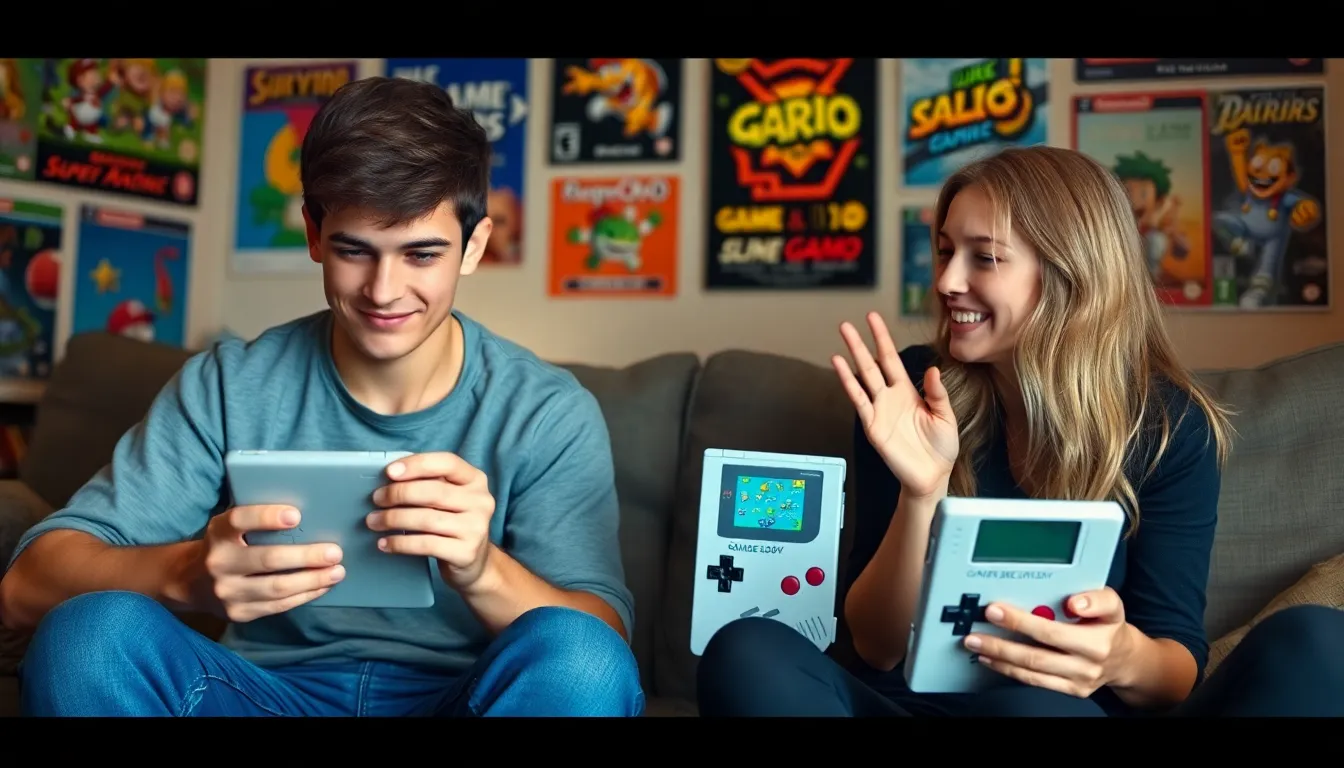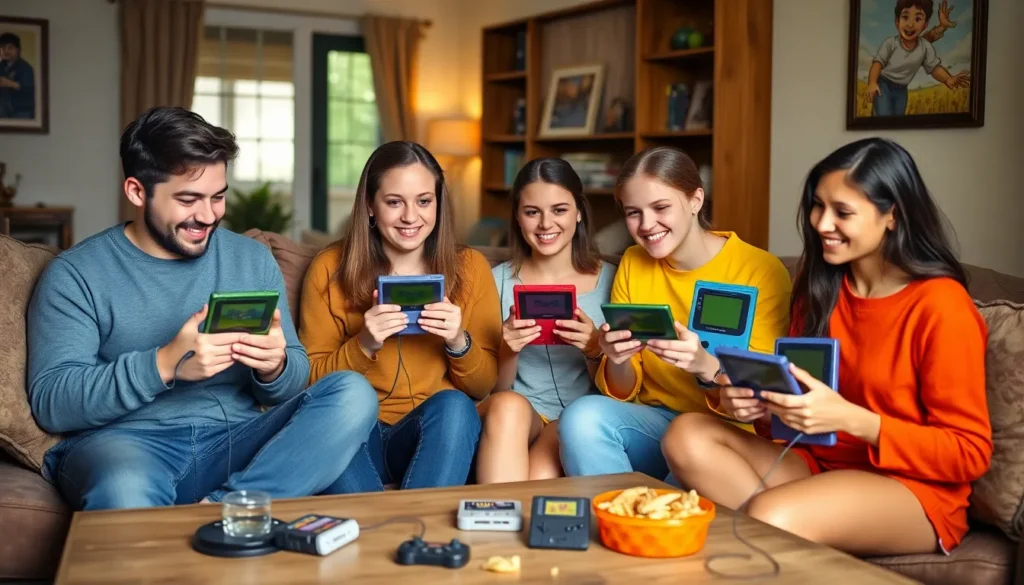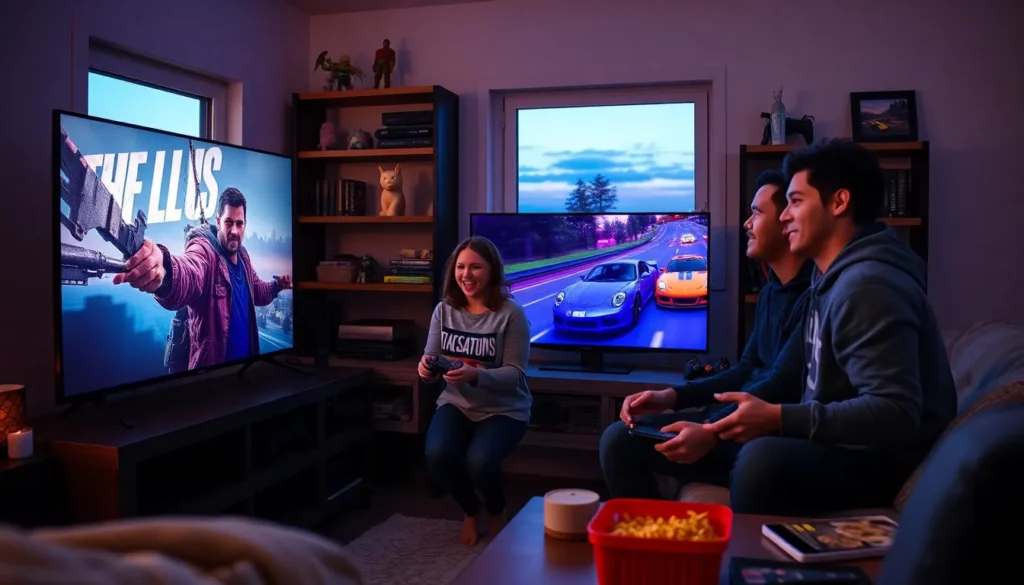Table of Contents
ToggleThe Game Boy revolutionized portable gaming, but its multiplayer capabilities often get overshadowed by its iconic single-player titles. With a simple link cable, players could connect their devices and dive into thrilling multiplayer experiences, paving the way for social gaming on the go. From epic battles in “Pokémon” to cooperative adventures in “The Legend of Zelda,” the Game Boy created unforgettable moments that brought friends together.
Exploring the world of Game Boy multiplayer reveals a rich tapestry of games and experiences that defined a generation. Whether competing against friends or teaming up for co-op missions, the innovative design of the Game Boy made it possible to enjoy gaming in a shared environment. This article delves into the history and impact of multiplayer gaming on this beloved handheld console, highlighting the titles that made it a cornerstone of social gaming culture.
Overview Of Game Boy Multiplayer
Game Boy multiplayer functionality played a crucial role in the evolution of portable gaming. This section delves into its brief history and its significance in gaming culture.
Brief History
Game Boy’s multiplayer capabilities emerged with the original system in 1989. The introduction of the Game Link Cable allowed players to connect their devices for head-to-head gameplay. Popular titles like “Pokémon Red” and “Pokémon Blue” were among the first to utilize this feature, enabling trading and battling between players. As the Game Boy line evolved, so did multiplayer experiences, with additional titles such as “Dr. Mario” and “Mario Kart” offering competitive gameplay. In 2001, the Game Boy Advance expanded multiplayer options with wireless capabilities, further enhancing social engagement in gaming.
Importance In Gaming Culture
Game Boy multiplayer experiences fostered community and social interaction among gamers. Players shared devices and gathered for competitive sessions, creating bonds through shared experiences. These interactions contributed to a culture of cooperation and competition, helping shape gaming communities. Iconic multiplayer moments, such as trading Pokémon or racing in “Mario Kart,” solidified the shared enjoyment of gaming. The multiplayer capabilities also paved the way for future handheld systems, influencing designs that prioritize social engagement in gaming experiences.
Game Boy Multiplayer Modes

Game Boy multiplayer modes significantly shaped the gaming experience, enabling players to connect and engage with one another in fun and competitive ways. This section explores two key multiplayer options: Link Cable Technology and Wireless Options.
Link Cable Technology
Link Cable technology, introduced with the original Game Boy in 1989, allowed direct connection between two devices. Players connected their Game Boys using a special cable, enabling head-to-head gaming and cooperative play. Popular titles utilizing this feature included “Pokémon Red,” “Pokémon Blue,” and “Dr. Mario.” This technology facilitated trading Pokémon and battling opponents, enriching gameplay and enhancing social interaction. The use of Link Cables symbolized a pioneering step toward collaborative gaming, laying a foundation for future multiplayer advancements.
Wireless Options
The Game Boy Advance expanded multiplayer possibilities with wireless options introduced in 2001. The built-in infrared sensor enabled players to connect without cables, promoting a more flexible gaming experience. Titles such as “Mario Kart: Super Circuit” and “Final Fantasy Tactics Advance” demonstrated the effectiveness of this feature. Wireless gaming fostered a casual social environment, allowing gamers to engage in competitive play and shared experiences in varied settings. The shift toward wireless connectivity represented a major evolution in the handheld gaming landscape, influencing the design of later systems and multiplayer features.
Popular Multiplayer Games
Multiplayer experiences on the Game Boy featured iconic titles that captivated players and encouraged social interaction. Both classic games and hidden gems contributed to the system’s reputation.
Classic Titles
Classic titles like “Pokémon Red,” “Pokémon Blue,” and “Mario Kart: Super Circuit” significantly shaped the multiplayer landscape.
- “Pokémon Red” and “Pokémon Blue” allowed players to trade and battle, boosting community engagement.
- “Dr. Mario” provided competitive puzzle-solving action, allowing up to two players to challenge each other to eliminate viruses.
- “Super Mario Advance 4: Super Mario Bros. 3” offered simultaneous gameplay, with players teaming up to navigate levels or compete for points.
These games not only defined an era but also laid the foundation for future multiplayer experiences on handheld devices.
Hidden Gems
Hidden gems emerged in the Game Boy’s library, showcasing unique multiplayer features that often went unnoticed.
- “Guilty Gear: Dust Strikers” introduced a fighting experience with accessible mechanics and competitive play.
- “Tetris” and its multiplayer mode allowed for head-to-head matches, with players racing to clear lines while sabotaging opponents.
- “Final Fantasy Tactics: The War of the Lions” featured multiplayer options that allowed players to test their strategic skills against each other.
These lesser-known titles expanded the multiplayer offerings, assisting in cultivating memorable gaming moments among friends.
Social Impact Of Game Boy Multiplayer
Game Boy multiplayer experiences fostered vital social interactions and community engagement among players. The technology not only connected devices but also facilitated bonding moments and friendships.
Player Interactions
Player interactions defined the Game Boy multiplayer experience. Game Link cables enabled head-to-head competitions and cooperative gameplay. Titles like “Pokémon Red” and “Pokémon Blue” encouraged players to trade Pokémon, fostering cooperation. “Dr. Mario” promoted friendly competition, challenging players to solve puzzles faster than their opponents. The excitement of defeating a friend in “Mario Kart: Super Circuit” or collaborating in cooperative missions enhanced social ties. Players shared strategies, celebrated victories, and created memories, forming lasting connections through shared gaming experiences.
Community Building
Community building thrived through Game Boy multiplayer features. Players formed groups around popular titles, organizing trading events or tournaments. These gatherings fostered a sense of belonging and camaraderie among gamers. Forums and fan clubs emerged, nurturing discussions and the sharing of gameplay tips. Game Boy’s multiplayer capabilities influenced the creation of communities, both local and online. As players connected and engaged over shared interests, they contributed to a larger gaming culture. This environment of collaboration shaped the future of handheld gaming, prioritizing social interactions and community engagement.
The Game Boy’s multiplayer capabilities played a pivotal role in shaping the gaming landscape. By connecting players through link cables and later wireless technology, it transformed solitary gaming into a social experience. Iconic titles not only fostered competition but also encouraged collaboration among friends, creating lasting memories.
This evolution of multiplayer gaming on the Game Boy laid the groundwork for future handheld systems to prioritize social interaction. The sense of community built around these games continues to resonate with gamers today, proving that the joy of playing together transcends generations. The legacy of Game Boy multiplayer remains a testament to the power of connection in gaming.







